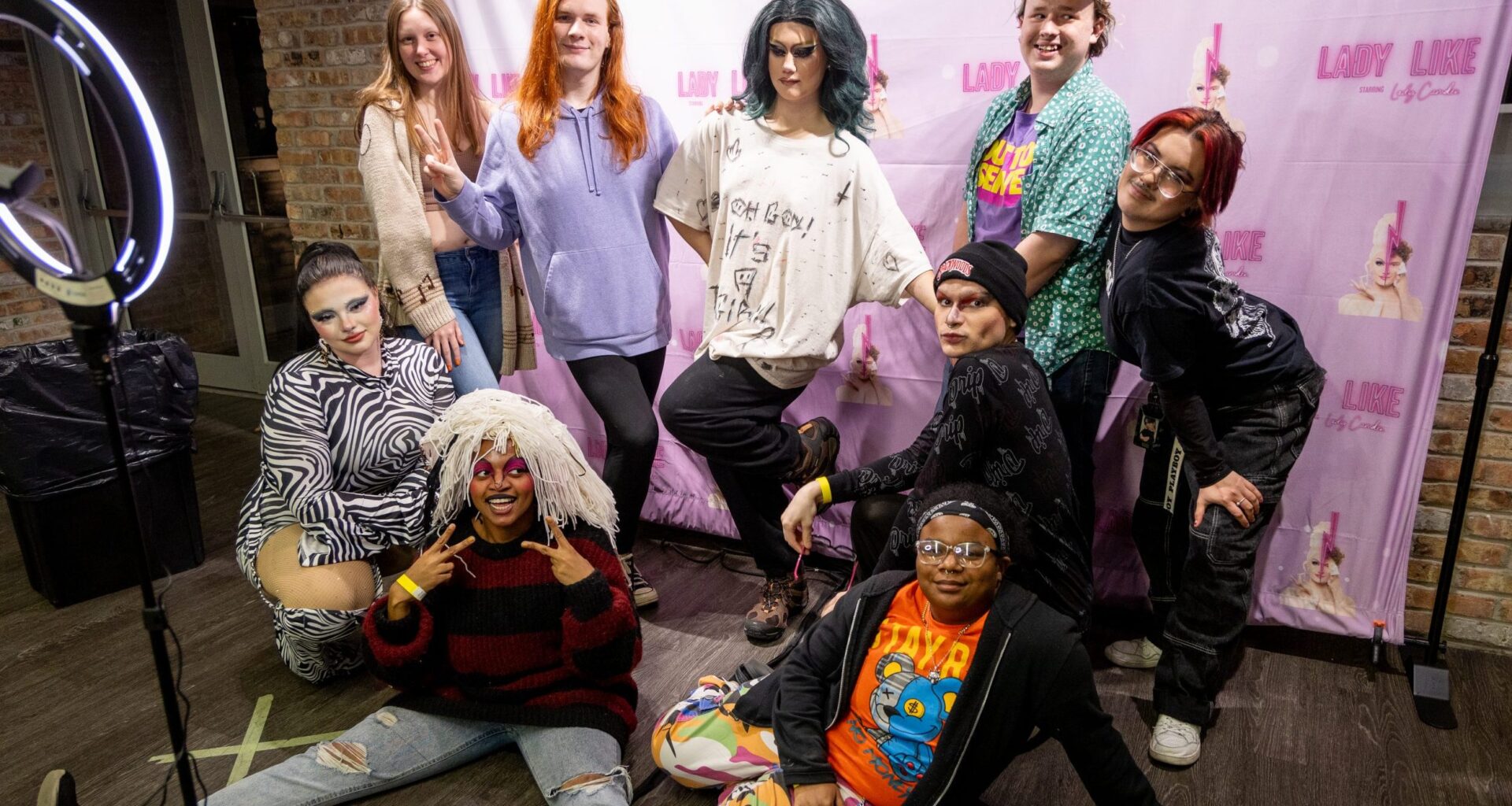Note: The following article was possible through a grant provided through Comcast.
On Chicago’s West Side, the ballroom scene doubles as a lifeline for LGBTQ+ youth.
Every week, teens are drawn into TaskForce Prevention & Community Services for its popular Vogue School. Once there, they then have access to a variety of resources like housing support, a food pantry, fresh produce and mental health services.
For many, it’s the only affirming environment in their neighborhood.
“We’re located here in Austin, and there isn’t really any other LGBTQ+ youth program like us on the West Side,” said Reyna Ortiz, program director at the nonprofit. “It’s special because young people don’t have to go Downtown or to the North side to feel like they belong here.”
Ortiz’s perspective underscores a long-standing reality that access to LGBTQ+ youth resources often depends on your zip code.
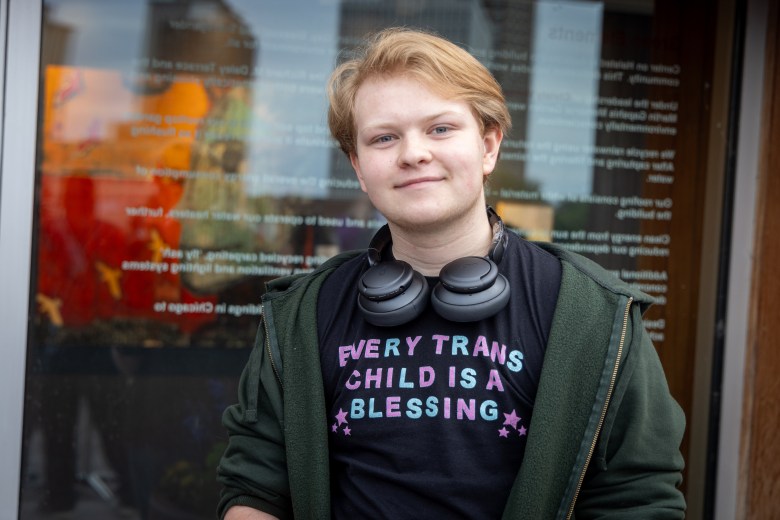 A participant in Center on Halsted’s youth program wears a shirt that says _Every Trans Child is a Blessing._ Photo by Kathleen Hinkel for Center on Halsted
A participant in Center on Halsted’s youth program wears a shirt that says _Every Trans Child is a Blessing._ Photo by Kathleen Hinkel for Center on Halsted
The city’s largest LGBTQ+ institutions have a prominence on the North Side, which is home to LGBTQ+ enclaves like Northalsted and Andersonville. This can leave queer youth on the South and West sides having to face longer commutes and other barriers when trying to access affirming services.
And when queer youth don’t have these kinds of resources nearby, it can create gaps that shape their health, education and economic futures. But North Side-based institutions—as well as smaller LGBTQ+ orgs on the South and West sides and some citywide organizations—are working to fill these gaps.
Concentration of resources
Two of Chicago’s largest LGBTQ+ organizations, the Center on Halsted and Howard Brown Health’s Broadway Youth Center, are both situated on the North Side.
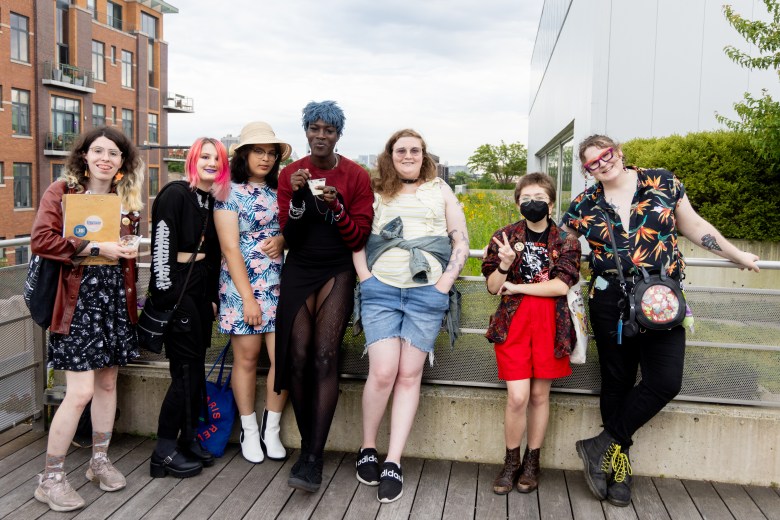 LGBTQ+ youth photographed at Center on Halsted’s Trans Ice Cream Social event. Photo by Kathleen Hinkel for Center on Halsted
LGBTQ+ youth photographed at Center on Halsted’s Trans Ice Cream Social event. Photo by Kathleen Hinkel for Center on Halsted
At Center on Halsted, 3656 N. Halsted St., youth and family programming spans drop-in spaces, leadership and mentoring opportunities and support groups for LGBTQ+ youth. statewide LGBTQ+ hotline provides additional access for young people beyond its Lakeview base.
CEO Joli Robinson said the Center has been intentional about expanding youth programming beyond the North Side through partnerships with other LGBTQ+ organizations and by introducing programs to its South Side location, the Center on Cottage Grove, 6323 S. Cottage Grove Ave.
“A week or so ago, we started our first drop-in space at the Center on Cottage Grove, which has been a priority for us over the past year and a half that I’ve been with the organization,” Robinson said. “We also partner with organizations like Chicago House and Life is Work, … and work to strengthen relationships with the GSAs in schools and PFLAG organizations that exist on the South and West sides.”
These kinds of collaborations are crucial to reaching LGBTQ+ youth in all neighborhoods of Chicago, Robinson said.
“These are organizations that they may already have a strong relationship with, and by deepening our partnerships with them, we’re leveraging the expertise of people who are in these neighborhoods to make sure we’re working in collaboration,” Robinson said.
The Broadway Youth Center, 1023 W. Irving Park Road, serves LGBTQ+ youth ages 12 to 24, particularly those experiencing homelessness or housing instability. It provides integrated medical and mental health care, sexual and reproductive health services, case management and mental wellness support.
The Broadway Youth Center’s drop-in space also offers meals, clothing, showers and other essentials, while cultural programming like art and dance provides additional affirming outets.
Both organizations state their programs are open to youth citywide and emphasize outreach through hotlines, housing services and broader support networks.
Still, their physical bases on the North Side mean that young people in other parts of the city often face barriers to access them.
“And we don’t want transportation to be a barrier for individuals,” Robinson said. “We don’t want location to be a barrier for individuals to participate in some of our programming, so it really is incumbent upon us to be very strategic and think creatively about how we engage the full city.”
Filling gaps on the South and West sides
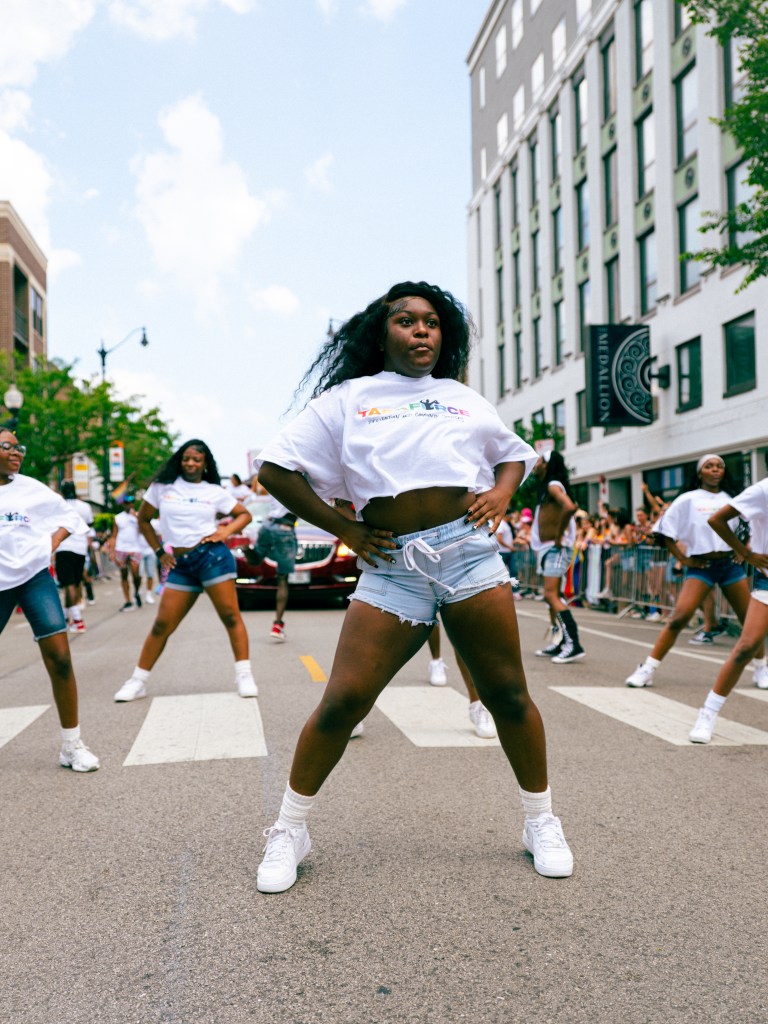 Youth from TaskForce performing at the 2025 Chicago Pride Parade. Photo by Maximo Solorzano for TaskForce
Youth from TaskForce performing at the 2025 Chicago Pride Parade. Photo by Maximo Solorzano for TaskForce
TaskForce is among the organizations working to fill these gaps.
Based in Austin on the West Side, the nonprofit offers youth services that are culturally specific, including housing support, food access, and sexual health testing.
Equally as important is TaskForce’s Vogue School, which uses voguing and ballroom culture to strengthen community and encourage self expression.
“Ballroom is important because it’s the one place where they can showcase their talents, where they can showcase who they are without any type of restrictions, without any type of judgment,” Ortiz said. “Ballroom and vogue are how our kids see themselves celebrated. It’s culture, it’s community, and it’s also leadership development.”
Ortiz said TaskForce also provides a steady presence in a neighborhood where resources are limited.
“We are consistent, we are here, we are present and we are open,” Ortiz said.
TaskForce is also home to PrEP 4 Teens, a citywide program focused on HIV prevention and sexual health among youth. While it’s open to teens across Chicago, staff said they are especially focused on reaching those on the South and West Sides who often face the steepest barriers to access.
“We’re looking to collaborate more with agencies, both in the south and west side of Chicago,” said program lead David Gauna. “We know those are the young people who need us most.”
That focus reflects the larger imbalance in the city.
“It’s about equitable access,” said Jim Pickett, one of the program’s organizers. “And so there’s a real lack of equity throughout Chicago, and we could certainly have a much more equitable distribution of opportunities.”
PrEP4Teens was shaped by youth themselves, Gauna added.
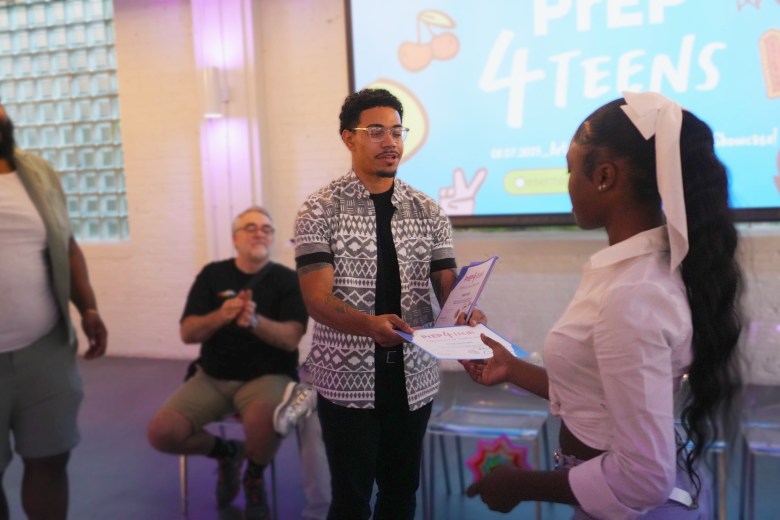 A PrEP4Teens leader handing out a program completion certificate at the 2025 PrEP4Teens Arts and Health Ambassador Program Art Showcase. Photo by Hannah Peweeonce bee.
A PrEP4Teens leader handing out a program completion certificate at the 2025 PrEP4Teens Arts and Health Ambassador Program Art Showcase. Photo by Hannah Peweeonce bee.
“Young people created this,” Gauna said. “They decided the colors, the imagery, the language. They said, ‘We don’t want this to be medical. We want this to be something fun. We want this to be engaging.’”
That youth-driven design is what makes it resonate, said Skai Underwood, who also runs PrEP4Teens.
“We try to meet youth where they are, and culture is part of that,” Underwood said.
Schools can also play a part in filling these gaps on the South and West sides.
“I think that there’s a great opportunity for schools to be like the glue that brings everything together,” said Julio Flores, program director for the Alliance, which promotes school safety for LGBTQ+ youth through advocacy, education, youth programming and research.
For some students, he said, school-based GSAs are the only affirming space they have.
“A GSA can be the only affirming space a young person has,” Flores said.
And those spaces can change a student’s trajectory, he added.
“When young people can lead a GSA, they’re not just building community, they’re building the skills they’ll use in college, in jobs and in life,” Flores said.
Why geography matters for opportunity
The gaps in geography don’t just shape whether young queer people can find community. They also shape whether they’re set up to succeed.
At TaskForce, Ortiz said success often begins with visibility. Young people who first came in for the Vogue School or drop-in services have gone on to train as medical assistants and phlebotomists.
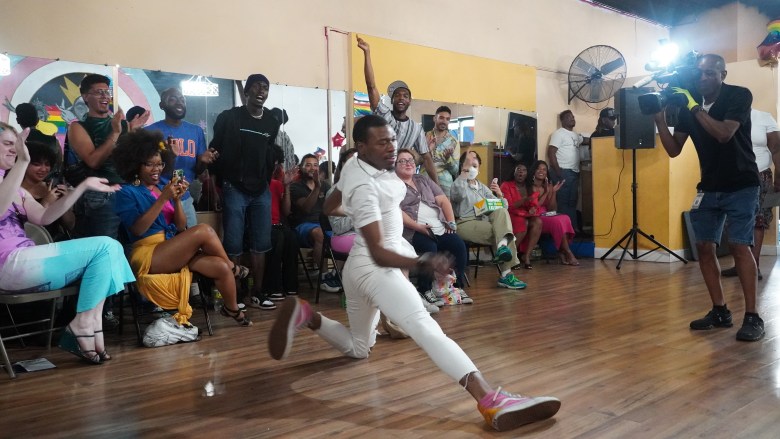 A Vogue performance at TaskForce’s 2025 Pride Ball. Photo by Hannah Pewee
A Vogue performance at TaskForce’s 2025 Pride Ball. Photo by Hannah Pewee
“Some of our youth that frequent the Vogue School start to volunteer. Then we hire and train them, and now they’re building careers,” Ortiz said.
For youth involved with PrEP 4 Teens, growth is just as tangible.
Gauna said teens were engaged in a program that empowered them to build the look, feel and voice of a PrEP awareness campaign. By the end of the cohort, youth who had once been too shy to speak were leading workshops, presenting artwork and giving speeches.
“They started off super shy… and by the end they were showcasing what this program had done for them — not just to take charge of their sexual health, but to feel a lot more confident in themselves,” Gauna said.
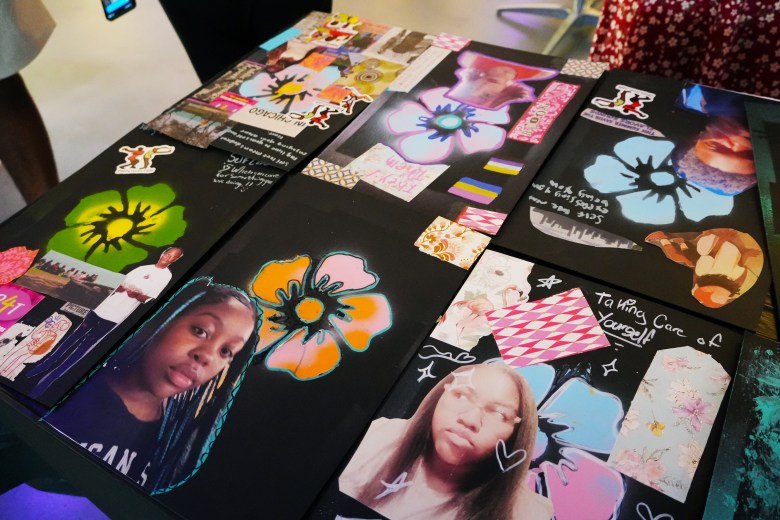 Artwork created by youth from the 2025 PrEP4Teens Arts and Health Ambassador Program. Photo by Hannah Pewee
Artwork created by youth from the 2025 PrEP4Teens Arts and Health Ambassador Program. Photo by Hannah Pewee
Pickett tied those individual transformations back to the bigger picture.
“So many queer young people of color don’t necessarily have many safe spaces throughout the day in their lives,” he said. “Providing these opportunities to engage with other young people and develop their skills and have fun and be fully who they are is so empowering. It sets them up for success.”
Robinson of Center on Halsted said the link between geography and opportunity often comes down to whether young people have their most immediate needs met close to home. Without food, shelter or a safe place to connect, long-term success could remain out of reach.
“For people to really have the safety and security they need to think about economic development or to be provided with a stronger footing and foundation to focus on maybe college or career, they need to have some of their most basic needs met,” Robinson said.
Related
